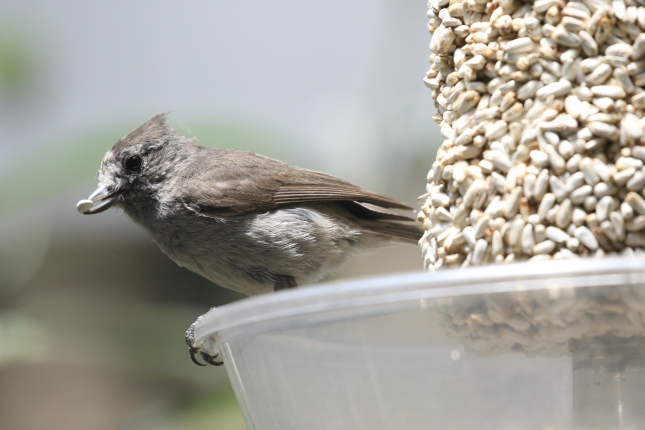Oak Titmouse
- Oak Titmice are small songbirds with short, stubby bills, a short crest on the head, and a medium-long tail.

- Active and constantly moving, Oak Titmice eat seeds and insects that they glean from bark and leaves. Listen for their rapid, harsh calls from the tops of oaks year-round.
- Within their restricted range Oak Titmice visit feeders with sunflower seeds and other birdseeds, particularly when tree cover is nearby. They prefer seeds on raised trays or tubes rather than ground feeders.
- The Oak Titmouse sleeps in cavities or in dense foliage. When roosting in foliage, the titmouse chooses a twig surrounded by dense foliage or an accumulation of dead pine needles, simulating a roost in a cavity.
- The Oak Titmouse mates for life, and pairs defend year-round territories. Most titmice find a mate in their first fall. Those that do not are excluded from territories and must live in marginal habitat until they find a vacancy.
- The Oak Titmouse’s species name, inornatus, means “plain,” appropriately for this very drab-plumaged bird. Taxonomists used to lump the Oak Titmouse with the Juniper Titmouse, referring to both as the Plain Titmouse. Though the two sister species look very similar, the Juniper Titmouse sings differently and lives mainly among not oaks but junipers. Their ranges overlap only in extreme northern California.
In its pursuit of insects and plant materials, the Oak Titmouse forages at a rate of about 40 food-catching attempts every 15 minutes. - The oldest Oak Titmouse on record was at least 9 years old when it was recaught and rereleased during banding operations in California.
- Oak Titmice can be found be found quite readily in the Conejo and San Fernando Valleys.
- The plural Titmouse can be either Titmouses or Titmice.
Information supplied by https://www.allaboutbirds.org/guide/Oak_Titmouse/overview

